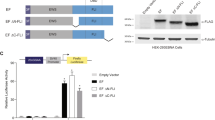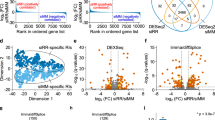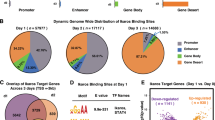Abstract
The proto-oncogene Fli-1, a member of Ets family is rearranged or activated through proviral integration in erythroleukemias, induced by Friends' Murine Leukemia Virus. The DNA binding domain (ETS domain) of Fli-1 is fused to the RNA binding domain of EWS by t(11q24:22q12) chromosomal translocation in Ewing's sarcoma and primitive neuroectodermal tumors. Screening of human cDNA libraries has identified two different 5′-termini and alternatively spliced forms of the human Fli-1 gene (Fli-1b), suggesting the possible existence of two independent promoters. The genomic sequence adjacent to the alternate exon of human Fli-1b gene shows functional promoter activity when cloned in promoter-less CAT expression vector and transfected into QT-6 cells. The transcription initiation (CAP) site and minimum promoter region necessary for function were localized. The 5′-flanking regions of human Fli-1b and mouse Fli-1 show 80% homology suggesting conserved promoter regulatory elements. The Fli-1b 5′-flanking sequence lacks canonical TATA or CCAAT boxes but contains a partially conserved TATA-like sequence at position 242. Several transcription factor binding sequences like ATF/CREB, E2A-PBX1, EBP, PEA-3, ETS-2, Sp-1, c-Myc, TBP, GATA-1 and Oct-3 were conserved in the promoter sequence. Functional promoter assays revealed that Fli-1b promoter shows very strong transcriptional activation compared to Fli-1 promoter. We also showed that variant Fli-1b has transcriptional activation properties similar to those of Fli-1. Fli-1b and Fli-1 show differential expression in various hematopoietic cell lines. This differential expression and promoter activities of Fli-1 and Fli-1b suggests that several mechanisms are involved in Fli-1 gene regulation which are mediated by many transcription factors.
This is a preview of subscription content, access via your institution
Access options
Subscribe to this journal
Receive 50 print issues and online access
$259.00 per year
only $5.18 per issue
Buy this article
- Purchase on Springer Link
- Instant access to full article PDF
Prices may be subject to local taxes which are calculated during checkout
Similar content being viewed by others
Author information
Authors and Affiliations
Rights and permissions
About this article
Cite this article
Dhulipala, P., Lee, L., Rao, V. et al. Fli-1b is generated by usage of differential splicing and alternative promoter. Oncogene 17, 1149–1157 (1998). https://doi.org/10.1038/sj.onc.1202030
Received:
Revised:
Accepted:
Published:
Issue Date:
DOI: https://doi.org/10.1038/sj.onc.1202030
Keywords
This article is cited by
-
Role of protein–protein interactions in the antiapoptotic function of EWS-Fli-1
Oncogene (2004)
-
Biology of EWS/ETS fusions in Ewing's family tumors
Oncogene (2001)
-
The role of Fli-1 in normal cell function and malignant transformation
Oncogene (2000)
-
The Ets-transcription factor family in embryonic development: lessons from the amphibian and bird
Oncogene (2000)
-
Alternative promoters and RNA processing in expression of the eukaryotic genome
Molecular Biology (2000)



